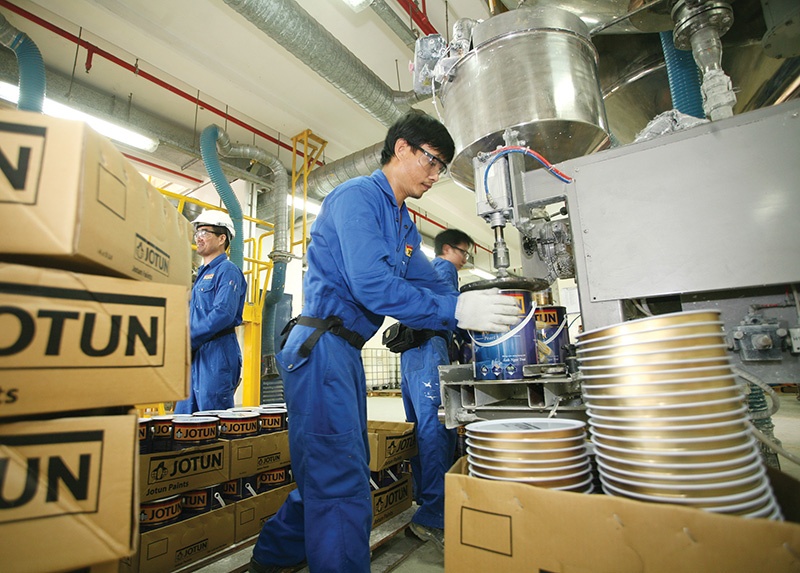Smooth and gradual reopening to be key
 |
| Vietnam’s industrial and economic zones have created 4.5 million jobs. Photo: Le Toan |
Dony Garment JSC was forced to suffer a loss of $17,400 on an order of school uniforms to the United States in September due to the summer restrictions. “Despite heavy losses, we’re at least able to keep reputation among our customers,” said general director Pham Quang Anh.
Orders for the year-end shopping season have been cancelled, and Dony also missed another order to export garment products to the Middle East. “We couldn’t accept it because we don’t know when we’ll be able to return to normal production,” Anh told VIR.
Dony has been working hard to keep production active with the help of the stay-at-work model, with September’s productivity increasing to 30 per cent, higher than the rate in August. But bringing productivity to 100 per cent will need much efforts.
Vu Thi Huong Giang, external affairs director at Nike Vietnam Co., Ltd., said at a government meeting with foreign businesses on September 20, “Nike’s partners in the southern cities and provinces all hope to receive sufficient vaccines for their workers and soon reopen to restore production.”
She added, “To reduce costs, Nike’s partners suggested that cities and provinces avoid extensive testing and do not close businesses whenever an infection occurs.”
Nike’s supply chain includes 38 countries. In Thailand, the number of COVID-19 infections is three times higher than in Vietnam, but none of Nike’s factories have had to close. India was also severely affected by the pandemic, but most places only stopped working for about three weeks and the production chain was restored very quickly.
In Vietnam, many supply chains broke down amid the latest wave as some businesses did not meet the regulations to operate during the outbreak.
The impact on the manufacturing sector became even more severe in August, and the current restrictions caused several businesses to temporarily close. The number of businesses affected by the pandemic and kicked out of the market or completing procedures for dissolution in the first nine months of 2021 was 90,300, up from 66,200 in the same period in 2020, in which Ho Chi Minh City alone has had about 30,000 businesses leaving the market.
Meanwhile, social distancing and movement restrictions led to a decline in output, new orders, purchasing power, and employment. The number of employees working in industrial enterprises as of August 1 decreased by 5.3 per cent on-month and by 10.6 per cent on-year, in which state-owned enterprises’ workforce decreased by 0.8 and 4.3 per cent, respectively; non-state enterprises’ by 5.6 and 9.7 per cent, respectively; and foreign-invested enterprises decreased by 6 and 12 per cent.
According to the Ministry of Planning and Investment, Vietnam has nearly 400 industrial zones (IZs) economic zones, export processing zones, and high-tech parks, attracting capital of about $126 billion and creating jobs for 4.5 million people. Up to now, the country has not had any accurate statistics and investigations on the extent of the damage done to businesses and the economy. However, the export value of the 19 southern cities and provinces applying the prime minister’s Directive No.16/CT-TTg released in March 2020 on measures against COVID-19 is equivalent to about $391 million per day.
During the pandemic, many businesses still maintained production and continued to export, but the above figures showed that if the economy continues to stagnate, there would come a time when almost all businesses have to stop production, with the caused damage huge.
The World Bank recently lowered its GDP growth forecast for Vietnam, which is expected to be only about 4.8 per cent for the whole of 2021, 2 per cent lower than the forecast made in December last year.
“The economy needs to be reopened cautiously,” commented Assoc. Prof. Dr. Dinh Trong Thinh from the Academy of Finance.
The purchasing power of the global markets is increasing steadily, and some countries are actively importing goods to serve the year-end shopping season. Thinh thought that it would be good for businesses to return to production as soon as possible, helping them to increase cash flow and cover expenses, as well as letting their staff return to work.
“Safe conditions and a suitable roadmap are the most important factors for the reopening of the economy. First of all, vaccinations must be widely deployed in cities with a high population density, IZs, and large enterprises,” Thinh said.
“The government should allow local authorities at the provincial and city levels to select businesses and IZs to reopen production in accordance with the local situation,” Thinh proposed.
He believed that a resolute and cautious reopening in early October will partly remove difficulties for businesses and help the economy to recover.
What the stars mean:
★ Poor ★ ★ Promising ★★★ Good ★★★★ Very good ★★★★★ Exceptional
Related Contents
Latest News
More News
- Vietnam M&A Forum 2025: new position, new momentum (December 09, 2025 | 14:30)
- FDI in Vietnam jumps on additional capital and share purchases (December 09, 2025 | 13:56)
- VIR gathers dealmakers for M&A forum (December 08, 2025 | 17:17)
- Vietnam steps up green transformation with strong policies and rising investment demand (December 06, 2025 | 12:07)
- Listed companies honoured for information transparency (December 06, 2025 | 11:59)
- CSI 2025 highlights rise of Vietnam’s green champions (December 06, 2025 | 09:00)
- Vietnam strengthens energy storage pathway (December 04, 2025 | 15:05)
- OECD projects moderation in Vietnam’s GDP growth over next two years (December 03, 2025 | 15:22)
- Manufacturing growth holds steady despite storm disruptions (December 02, 2025 | 10:06)
- Sustainable Development Conference 2025 recognises leaders in green growth (November 28, 2025 | 16:18)

 Tag:
Tag:


















 Mobile Version
Mobile Version